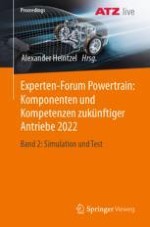2023 | OriginalPaper | Buchkapitel
Simulation of Oil Flow Behavior in the Air Gap between Rotor and Stator
verfasst von : Navid Shahangian, Leila Sharifian, Rüdiger Beykirch, Albert Jeckel, Silja Klier, Lothar Grupe
Erschienen in: Experten-Forum Powertrain: Komponenten und Kompetenzen zukünftiger Antriebe 2022
Verlag: Springer Fachmedien Wiesbaden
Aktivieren Sie unsere intelligente Suche, um passende Fachinhalte oder Patente zu finden.
Wählen Sie Textabschnitte aus um mit Künstlicher Intelligenz passenden Patente zu finden. powered by
Markieren Sie Textabschnitte, um KI-gestützt weitere passende Inhalte zu finden. powered by
Abstract
-
Turbulence: K-Omega SST
-
A statistical droplet transport model
-
Collision
-
Break-up
-
An analytical wall film model
-
A multi-component oil surrogate
